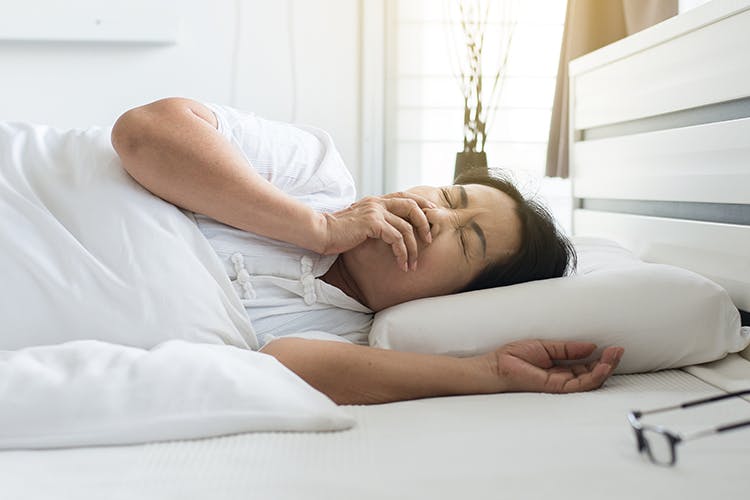What are the Symptoms of COPD and What are the Health Complications?

According to the American Lung Association, more than 11 million people in the United States suffer from Chronic Obstructive Pulmonary Disease, a condition more commonly known as COPD.

COPD causes long-term disability, depression, and early death; in fact, it’s the third most prevalent cause of death in the U.S. There’s currently no cure for COPD, but, if caught early, COPD can be treated and managed, so patients can live happily and productively for many years with their disease.
Since early detection is critical to successful management of COPD, it’s important to understand the nature of the disease, what causes it, how to recognize the early warning signs of COPD, and how to manage COPD.
What is COPD?
COPD is an umbrella term for several chronic inflammatory lung diseases that cause obstructed airflow from the lungs. Emphysema and chronic bronchitis are the two major diseases that fall in the COPD category, each obstructing airflow in slightly different ways.
- Emphysema causes the destruction of the thin, fragile walls of the alveoli. The lungs rely on these walls to be elastic and strong, expanding when you inhale and then contracting to force the air out. Alveoli affected by emphysema over expand upon inhalation and then collapse on exhalation, trapping air inside the lungs.
- Chronic bronchitis occurs when bronchial tubes are inflamed, narrowing the air passages and causing mucus to build up, resulting in a chronic cough.
Patients with COPD often have both emphysema and chronic bronchitis. Either way, when you breathe, the flow in and out of your lungs decreases, preventing oxygen from getting where it needs to go and trapping waste carbon dioxide inside. The resulting shortness of breath makes it increasingly difficult to stay active and do the things you love to do. Additionally, COPD is progressive and becomes worse over time.
What Causes COPD?
In developed countries, the main cause of COPD is smoking. Patients also get COPD from regular exposure to harmful fumes from cooking or heating fuel in poorly ventilated homes. For people in the U.S., you can significantly reduce your or a loved one’s chances of getting COPD by not smoking.

What are the Early Warning Signs of COPD?
Because early diagnosis is so critical to the treatment of COPD, it’s important to recognize early warning signs and symptoms of the disease, which include the following:
- Shortness of breath. Or, a persistent shortness of breath that feels unusual to the one affected.
- Chronic cough. This is a daily cough that lasts 3 months or more for at least 2 years. Watch for yellowish mucus and be aware of the need to clear the throat of excess mucus every morning upon waking.
- Chest tightness. While this soreness could be muscle pain from coughing, it might also be caused by changes in your lungs.
- Trouble sleeping. Feeling short of breath when lying down and then feeling anxious about breathing and chest pain can all interfere with your sleep.
- Fluid retention. COPD can cause excess fluid to build up in your feet and ankles.
- Frequent respiratory infections. Constant coughs and colds may be a sign that your lungs are struggling to do their job.
- Lack of energy. When you’re not getting the oxygen you need, you will notice a distinct lack of energy.
If you believe you’re at risk for COPD, it’s important to talk to your doctor right away if you are experiencing any of these symptoms. Don’t wait for things to get worse; successful treatment depends upon early diagnosis.
What are the Keys to Living With COPD?
COPD is a condition you live with on a daily basis; there’s no cure, but, with diligent care, you can manage your symptoms and slow the progression of the disease. If you or a loved one has been diagnosed with COPD, the first thing to do to slow the progression of the disease is to stop smoking, if the individual smokes. Beyond that, physicians use a number of tools to help patients manage their COPD, including the following:

- Most COPD medications are dispensed via inhalers. These meds include bronchodilators and steroids that are meant to relax the airways and open them by calming inflammation. Sometimes oral steroids and even antibiotics are used to treat inflammation and infection.
- Lung therapies. In advanced cases of COPD, additional lung therapies are often used to assist with breathing. Supplemental oxygen is the most common therapy used. You may need this oxygen full time or just when sleeping and doing physical activities.
Patients with COPD can experience periods of time, days or even weeks, when their symptoms are worse than usual; these events are called exacerbations. These can be serious and frightening. It’s important to carefully manage your environment to prevent dangerous exacerbations. Avoid triggering an exacerbation by doing to following:
- Stop smoking (if you haven’t already.)
- Avoid secondhand smoke.
- Minimize or eliminate your exposure to industrial compounds, fumes, chemicals, and dust.
- Stay inside when outdoor air quality is poor.
- Stay healthy. Wash your hands, avoid crowds during cold and flu season, brush your teeth regularly, and keep your vaccinations up to date.
24 Hour Home Care is here to help you manage your COPD. Our caregivers are carefully trained in the symptoms and management of all stages of COPD. We will assist you with your medications, help you manage your supplemental oxygen, and support your efforts to keep your environment free from potential triggers.
A diagnosis of COPD is not the end of the world. With the right medical care and good help, you can live a long and productive life with COPD.
